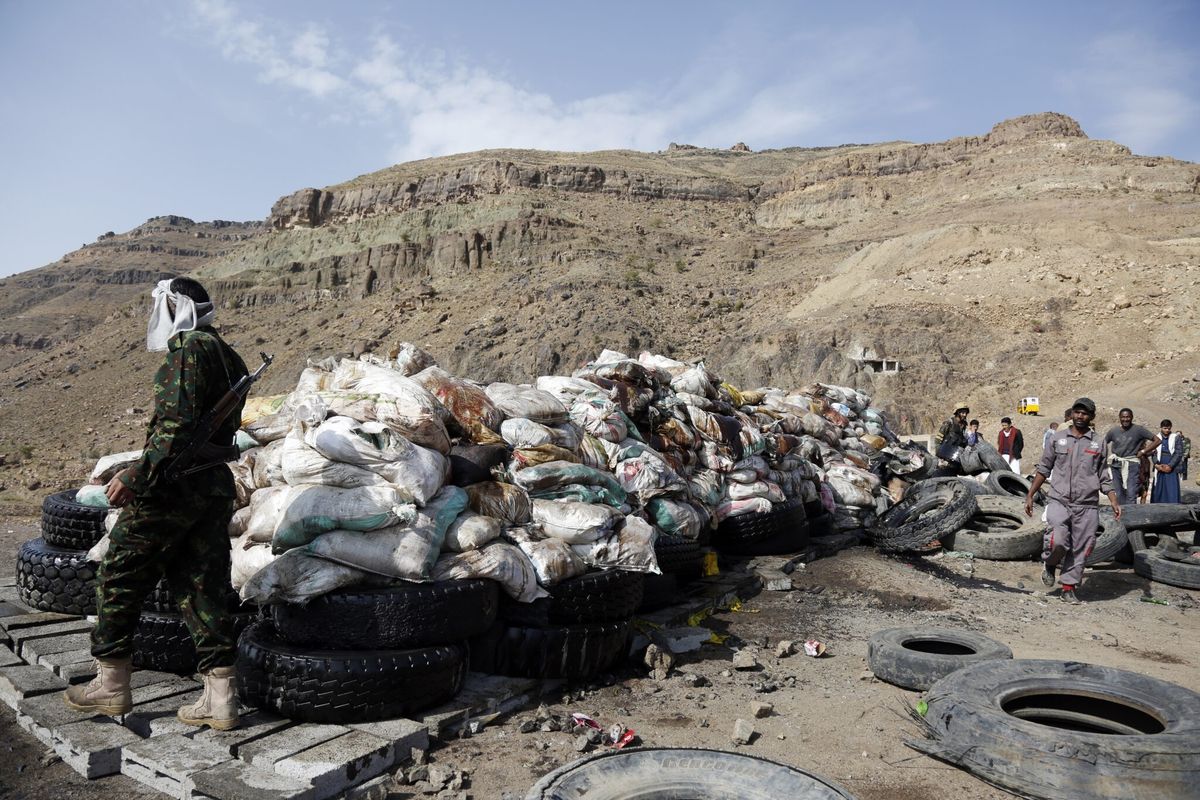As the U.S. public-health system struggles to alleviate the scourge of opioid addiction that killed more than 50,000 Americans in 2016, a variation on the theme is the ramifications of this class of drugs as chemical weapons. Among the drugs at the forefront of the health crisis are the highly addictive fentanyl and a derivative, carfentanil, a cheaper and more toxic substance that drug dealers cut into heroin to increase their profits. But in 2002, medical tests also identified carfentanil as the unknown incapacitating agent that suffocated hundreds of civilians, some fatally, in a siege by armed militants at a Moscow theater.
Existing legal frameworks for chemical weapons or narcotics are heavily focused on preventing the proliferation and use of chemicals that only have single purpose. However, dual-use chemicals such as chlorine or synthetic opioids do not easily fit into these categories; chemical substances with very common uses but that also possess deadly properties hover in the gray areas in between. Chlorine has drawn far more attention since al-Qaida weaponized it in Iraq and Bashar al-Assad used it against his own people in Syria. But existing international frameworks are coming up short in addressing these security concerns, given that these types of chemical substances are too ubiquitous to effectively regulate and control. Thus, there is a need for the international community to think outside current traditional frameworks to effectively handle this emerging threat.
As former Acting Director of the CIA and Cipher Brief expert Michael Morell wrote before the declaration of a U.S. public health emergency, “The public discussion about – and the government focus on – carfentanil is all about the dangerous role it plays in the contemporary drug epidemic – with good reason … But the drug also constitutes a significant threat to national security. It is a weapon of mass destruction.” He noted that carfentanil “comes in several forms – including tablets, powder, and spray. It can be absorbed through the skin or through inhalation. It acts quickly. And, it is deadly.”
In 1995, members of the Japanese doomsday cult Aum Shinrikyo dispersed large amounts of sarin gas on the Tokyo metro during rush hour. The horrific attack killed 12 people, severely injured 50 others and temporarily impaired the vision of anyone in range. In the October 2002 Moscow theater incident, Russian Special Forces dispersed an aerosolized toxic chemical agent to free more than 800 hostages inside the venue. Hundreds were injured and at least 117 civilians died from respiratory arrest.
A Tipping Point
While some of these attacks had more limited success than intended, their impact is staggering considering the crude methods of deployment. Today, we are reaching a tipping point in access to evolving technologies that could significantly ease the manufacture of high-impact toxic agents. Synthetic opioids such as fentanyl are among the toxic agents with dual-use applications in medicine and warfare, and they are spreading like wildfire around the world.
Nearly 100 times more potent than morphine and 30-50 times the strength of heroin, carfentanil can kill an adult male at a dose of only 3 milligrams. If dispersed in enclosed spaces like a metro station or theater, powerful fentanyl derivatives could incapacitate hundreds.
The challenge of controlling fentanyl emerges from both its supply and demand. Production is not geographically-constrained: unlike heroin, a morphine-derived opioid that is harder to make and much less powerful, fentanyl can be synthesized in any laboratory with access to its precursors.
It also is not hard to find: thousands of vendors sell it online anonymously and ship it via unmonitored international packages. For example, the Canadian Border Services Agency is only authorized to open packages weighing more than 30 grams without the supplier’s permission. Since only 1 gram of fentanyl can produce more than 1,000 pill-pressed tablets to be sold on the streets, the global supply is expanding at an unparalleled speed. Indeed, Nebraska and Nevada are thinking seriously about using fentanyl as an executioner's drug on death row because it is a lot easier to acquire. According to a report in the Washington Post, officials were able to order fentanyl through a pharmaceutical distributor with ease, making it a convenient option.
Policy No Match for the Supply Chain
It has become harder than ever for a high-level policy response to match that speed. As a dual-use item, the legality of fentanyl and its derivatives is determined through several drug-control schedules and chemical weapons regulations. In the United States, fentanyl is categorized on “Schedule II” of the Controlled Substances Act, indicating the second-highest potential for abuse.
Internationally, fentanyl and its derivatives are controlled substances under the 1961 Single Convention on Narcotic Drugs. In the Chemical Weapons Convention (CWC), incapacitating agents like carfentanil are not listed within a specific category, but they potentially can fall under the umbrella of Riot Control Agents (RCAs). RCAs are “prohibited as a method of warfare” under the CWC, so states that are parties to the convention must declare their use “for riot control purposes.” There is no list of controlled substances to define what constitutes an RCA, leaving the burden of interpretation to individual states and domestic enforcement. As carfentanil may not necessarily be declared under the CWC, it is difficult to monitor and regulate how states or non-state entities might use it as a chemical weapon.
In effect, international substance-control frameworks are only as strong as compliance by all state parties. Adapting to the ever-changing nature of synthetic opioids, the United Nations Commission on Narcotic Drugs frequently updates its controlled substance lists.
In contrast, amendments to the Chemical Weapons Convention are subject to a complex multilateral negotiation process. In both cases, legal implementation differs across regional and national legislative frameworks, with varying degrees of flexibility, delays and procedural steps that hinder compliance. Uneven legal landscapes create an even greater challenge to monitor compliance, which is how illicit supply chain proliferation is thriving.
New Approaches
We need new approaches that involve collaboration among various stakeholders to close the loopholes created by existing inconsistent frameworks. Some initiatives are emerging from international organizations and think tanks.
On a multi-national level, the U.N. Office of Drugs and Crime in 2008 launched a program called Global Synthetics Monitoring: Analyses, Reporting and Trends (Global SMART). To enhance the capacity of Member States to control emerging synthetic substances, the Global SMART program assists local authorities in collecting supply chain data and designing effective local policies.
In the policy research arena, the Stimson Center’s Security and Trade Efficiency Platform (STEP) program informs governments and industry representatives on ways that addressing security gaps can help improve supply chain efficiency. Acknowledging the variety of actors involved in illicit trafficking of dual-use items such as precursor chemicals, STEP partners with local public and private sectors to identify and suggest solutions that close supply chain loopholes. It might be possible to apply STEP to emerging, dual-use synthetic chemical substances, and show governments and industries the complex proliferation pathways, and the importance of coordinating across the health and security sectors.
Accelerated by technological advancements, dual-use agents like fentanyl will continue proliferating at an alarming pace. High-impact toxic agents are not only becoming deadlier but also easier to manufacture, thus leaving us imminently more vulnerable. The alternative approach that programs like STEP and SMART suggest is essential in addressing all facets of the opioid crisis. We need to start thinking outside the traditional boxes of state-level policy solutions to address the problem of chemical security.
Lovely Umayam is a Project Manager with Stimson’s Managing Across Boundaries initiative. Prior to Stimson, Umayam served as a Program Manager at the U.S. Department of Energy’s National Nuclear Security Administration, where she implemented nuclear safeguards projects in Southeast Asia and Latin America.
Endi Mato is a researcher at the Stimson Center's WMD, Nonproliferation and Security Program. She is currently pursuing a dual B.A. in International Politics and Economics at Smith College and is a member of the CTBTO Youth Group.












